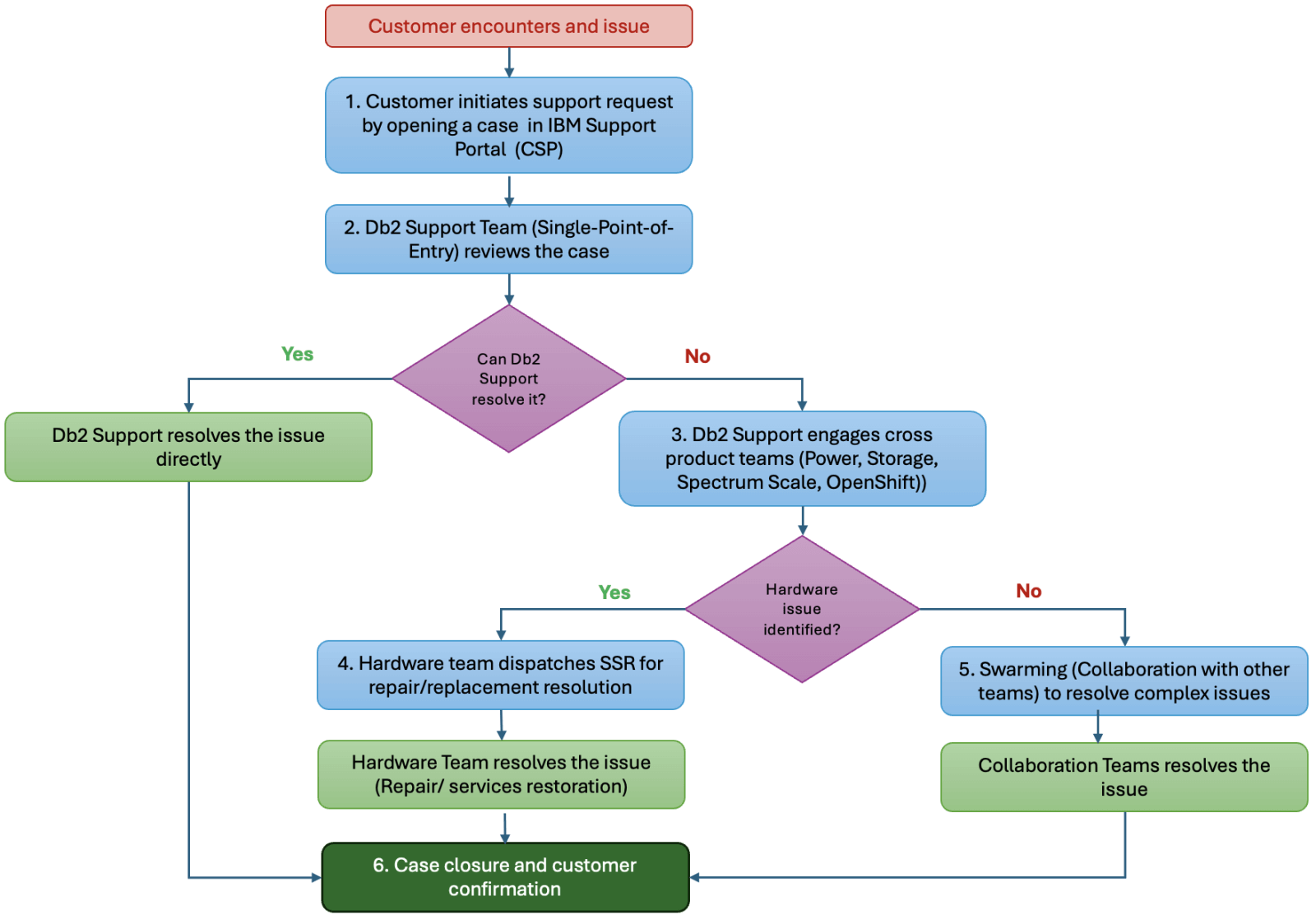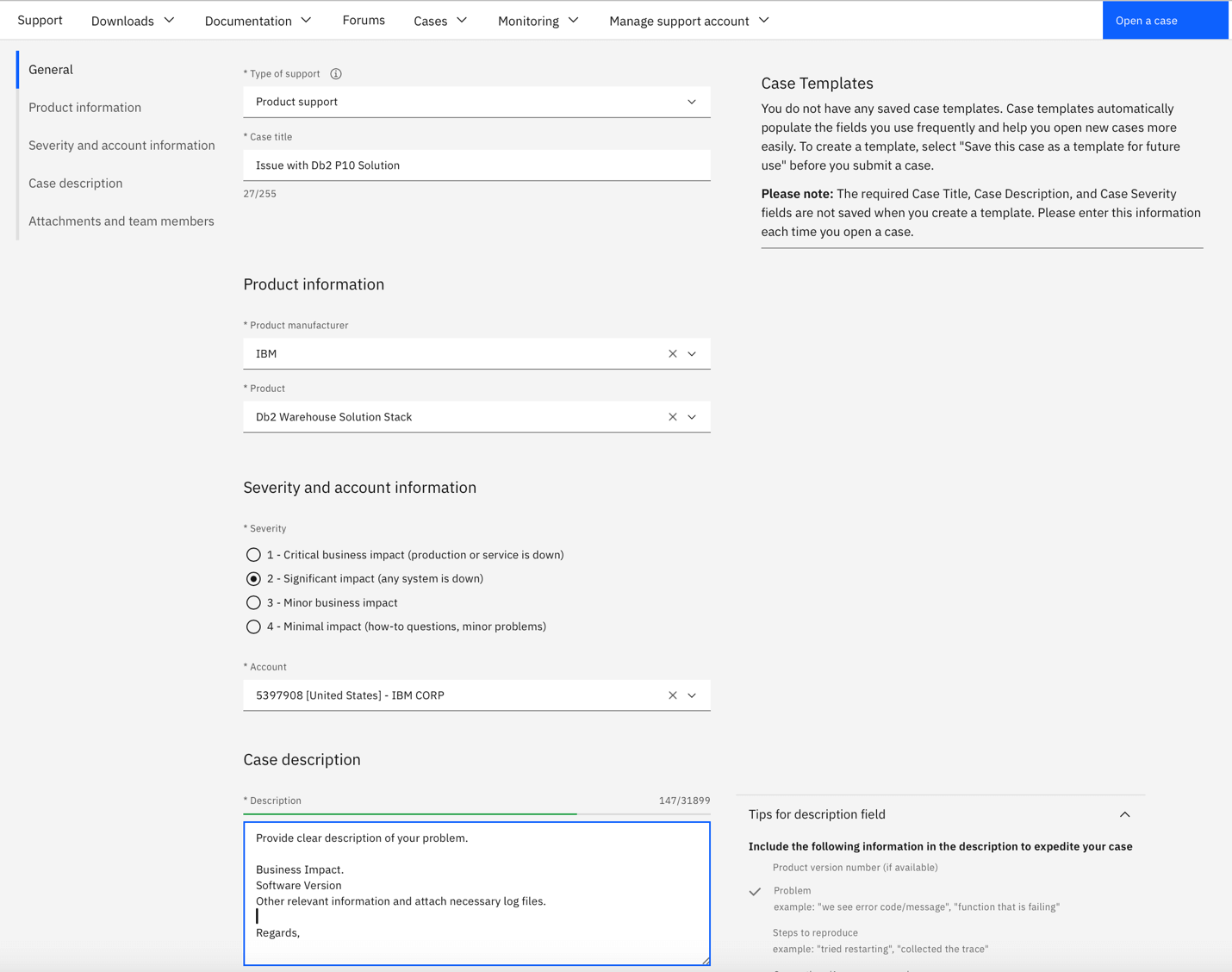IBM Power 10 Private Cloud Rack for Db2 Warehouse - Chapter 3: Step-By-Step Guide to Engage Support
By Sachin Jain and Jana Wong
Running mission-critical workloads demands more than just cutting-edge hardware—it requires fast, reliable support when issues arise. With the release of IBM's Power 10 Private Cloud Rack for Db2 Warehouse Solution, IBM has enhanced scalability, resiliency, and deployment flexibility. To complement these innovations, IBM offers two support options, Standard Support and Advanced Support.
This blog post explains how to engage IBM Support via Advanced Support Cartridge, offering Db2 Warehouse on Power10 users a streamlined, Single-Point-of-Entry for support. It is the third installment in our series, building on the foundational overview provided in Introducing IBM’s Power10 Private Cloud Rack for Db2 Warehouse Solution: Architecture, Scalability, and Performance and the performance insights shared in Power10 Private Cloud Rack for Db2 Warehouse Solution: Performance Deep Dive. For guidance on setting up your environment, be sure to also review the detailed Deployment Guide, which outlines the deployment for Db2 Warehouse, hardware, software, and infrastructure requirements for Power10-based systems.
This blog provides a step-by-step guide to ensure the right teams are engaged at the right time to deliver effective support. Notably, this support process is consistent with the model used across other IBM products, such as Db2, offering a familiar, streamlined experience that simplifies issue resolution and accelerates time-to-value.
The following flowchart illustrates the user experience when using the Advanced Support option for Db2 Warehouse on Power10 – from the moment an issue is identified to its resolution.

Figure 1: Flowchart: Navigating Support for Db2 Warehouse on IBM’s Power 10
Next, we will take a closer look at each step in the process to provide deeper insight and guidance.
Step #1: Customer Initiates the Support Request
The support process begins when a customer initiates a support request by opening a ticket through the Customer Support Portal (CSP). To do so, navigate to the portal and click on "Open a Case." When completing the form, be sure to select "Db2 Warehouse Solution Stack" as the product and provide all relevant details, including the case severity, a clear description of the issue, and any additional necessary information. Supplying comprehensive information at the outset helps expedite the support process and ensures that the case is routed appropriately. The image below displays a sample case template as it appears when a ticket is submitted through the Customer Support Portal (CSP).

Figure 2: Case Template for opening a new support ticket through the CSP
To follow up on an existing case, navigate to the “View My Cases” section and select the relevant case from your list. If there is an ongoing case that requires additional information, providing updates within the existing case ensures continuity and helps the IBM Support team resolve the issue more efficiently.
Step #2: Single Point of Entry (SPOE): Db2 Support Team
In Step 2, the Db2 Support Team serves as the Single Point of Entry (SPOE) for all tickets related to the Db2 Warehouse Solution Stack. Upon receiving a support ticket, the Db2 Support Team evaluates the issue and determines the appropriate next steps. Depending on the nature of the problem, they may either resolve the issue directly within the Db2 support scope or engage additional specialized teams—such as Power, or Storage —as needed to ensure a complete and efficient resolution.
Step #3: Engaging Cross Product Teams
In Step 3, if an issue requires support for Power, Storage, or other software components, the Db2 Support Team will engage the appropriate teams by opening a Skills Case. The respective Support Missions will be brought in as needed to address specific aspects of the issue. All IBM Support teams operate under established Business As Usual (BAU) procedures, ensuring a consistent and coordinated approach to problem resolution across all involved groups.
Step #4: Handling of Hardware Issues
In Step 4, if the investigation determines that hardware repair or component replacement is required, the Hardware Support Team will dispatch a Service Support Representative (SSR) with the necessary parts to complete the repair. Appropriate support teams will also be engaged to ensure a smooth repair process and the prompt resumption of Db2 services. To further streamline support, IBM highly recommends enabling the call-home capability via the Hardware Management Console (HMC). When call-home is activated, an automatic support case is created, allowing IBM Support to proactively manage hardware-related issues. For guidance on enabling the call-home feature, please follow the instructions here.
Step #5: Coordination for Complex Issues
In Step 5, when complex, multidisciplinary issues arise that require collaboration across teams—such as Db2, Power, and Storage—the Db2 Support Team will manage the overall coordination. The Db2 team will engage the necessary groups by opening Skills Cases as needed, facilitating communication and collaboration among the involved support and development teams. The primary goal is to ensure seamless teamwork and efficient resolution of complex issues, minimizing disruption to user operations.
Step #6: Case Monitoring and Closure
In Step 6, the Db2 Support Team continues to monitor progress across all engaged teams to ensure timely resolution and case closure. This approach aligns with the support model used across other IBM products, providing users with a familiar and streamlined experience that simplifies issue management and accelerates time-to-value.
Conclusion
In complex enterprise environments, seamless support is critical to maintaining performance and availability. Advanced Support Cartridge for Db2 designates Db2 Support as the single point of entry for all support needs. IBM then coordinates collaboration across specialized teams – such as Power, Storage, Spectrum Scale, and OpenShift - to ensures that issues are resolved quickly and efficiently. Whether it’s a simple software question or a cross-stack hardware incident, this structured support workflow empowers users to navigate challenges with confidence, keeping their Db2 Warehouse on Power 10 environments running seamlessly.
About the Authors
Sachin Jain is Data Warehouse and Lakehouse solution Architect (STSM). His major responsibilities are for data warehouse and data Lakehouse product support, ensuring customer success, successful deployments and PoC’s. Sachin have led many high visibility customers situation along with strategic PoC’s and Sales cycles. He is currently leading Product Serviceability initiatives with Watsonx.data and Db2wh P10 Solution. Sachin can be reached out at jsachink@us.ibm.com.
Jana Wong is the principal performance focal for Data Warehouse on-premise solutions at the IBM Silicon Valley Lab, with over 15 years of experience in Databases, SQL, QA, and Project Management. She holds a Master’s in Computer Science from the University of Rostock. Recently, she led the development and automation of a benchmark kit for validating IBM's Power10 Private Cloud Rack and played a key role in evaluating the performance of reference architectures such as IIAS/Sailfish and P10 PCR. Jana can be reached at jfitzge@us.ibm.com.
